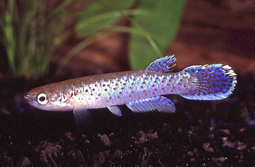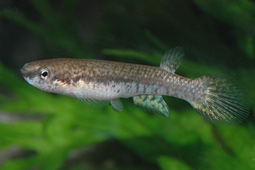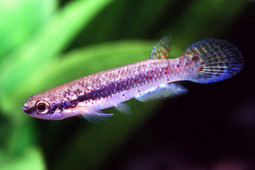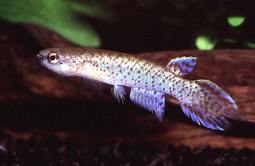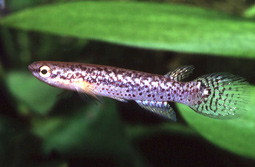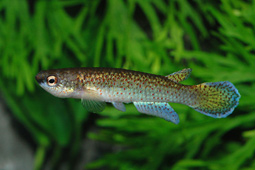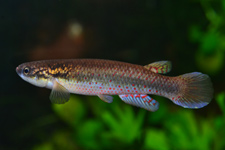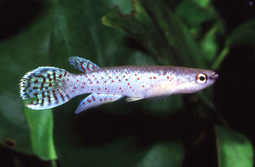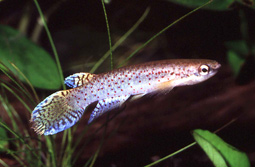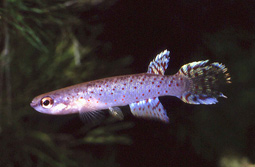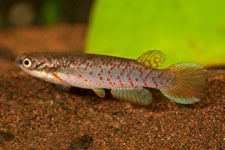History
Alternative name Melanorivulus punctatus.
Rivulus punctatus has an large spreading in the Rio Paraguay basin and its many tributaries. The type locality is situated at Colonia Risso, Paraguay. Most of the collectinglocalities are located in a large area around the city Asuncion, central Paraguay, and another concentration of collecting localities is more northerly along the border between Bolivia and Brasil (Mato Grosso). Rivulus punctatus is living more south than any other related member so far.
Rivulus punctatus was discovered by Alfredo Borelli in the year 1893. Dr. Wilson Costa (2006) assigned R. punctatus into a new subgenus called Melanorivulus. These components are R. apiamici, R. cyanopterus, R. dapazi, R. decoratus, R. egens, R. kayapo, R. litteratus, R. modestus, R. paracatuensis, R. panaibensis, R. pictus, R. pinima, R. punctatus, R. rossoi, R. rutilicaudus, R. scalaris, R. violaceus, R. vittatus and R. zygonectes.
Rivulus punctatus can be found in habitats with Pterolebias bokermanni, Trigonectes balzanii, Papiliolebias bitteri, Simsonichthys chacoensis in the Chaco, Pterolebias phasianus and Austrolebias nigripinnis in Argentina.
Reproduction
Keeping and breeding is easy but a good cover of the aquarium is necessary because there ability to jump, even true the smallest opening, is unbelievable.
This species can, if there is enough space for them, housed in a tank with more males than one only and several females. If separated before and brought together again however, they can be very agressive to each other and fight to become dominant to others. The best way to have much offspring is to put a pair or an trio in a small tank from 10 liters with a small filter in it or with some airation. On the bottom some peat moss or dark gravel and a floating "mop" to give space for laying there eggs. The fish will, if they become a rich varity of life food, spawn during there whole adult life and produce daily between 5 to 15 eggs.
The eggs should be collected by hand and stored for about 14 days in a small container. Eggs are 1.6 mm and amber colored. It is wise, to add to the water you store the eggs in, some acryflavine to provent fungus coming up.
After hatching the young fry can eat fresh artemia nauplii without any problem. It takes 4 to 5 months to raise them to maturity. Often the number of males is far above the number of females. For some species this can become a major problem for the breeder as he has to raise many young fishes and so become able to distribute a few pairs to other hobbyists. Recent personal tests laerned that lower pH levels during the time of hatching gave a higher percentage of females. To achieve this I use some peat moss that I add to the container with the egss just before they are ready to hatch. This peat moss also is a good way to prevent eggs to become attact by fungusses. There lifespan can be up to 3 years in captivity.
Remarks :
Rivulus punctatus is able to live temporarely in cooler environments and can stand temperutures of 12 C with no problems during a short period. Is is good to know that the species does not like temperatures higher than 24 C. On the other hand it lives in open grassland area's ( swamps in savannahs) that can get warmer in the summer also.
Variations
Map
Meristics
Max. size 3.5 cm.
Dorsal 8.0,
Anal 13.0,
D/A 10.1,
LL scale count (average)32.0
Pre- dorsal length to % SL – 79.0 %
Depth to % SL – 20.1 %
Literature
